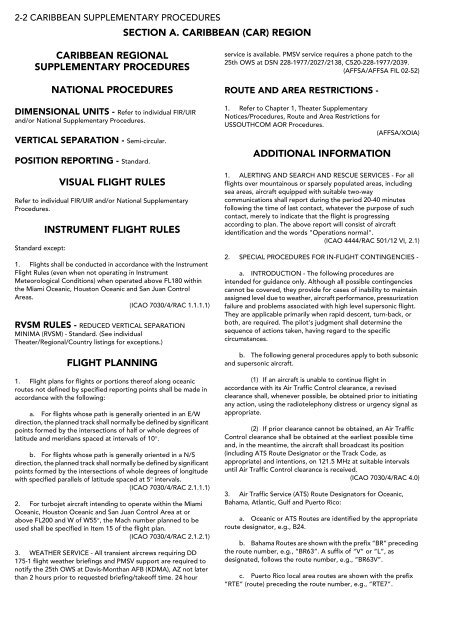NORTH AND SOUTH AMERICA - CNATRA - The US Navy
NORTH AND SOUTH AMERICA - CNATRA - The US Navy
NORTH AND SOUTH AMERICA - CNATRA - The US Navy
Create successful ePaper yourself
Turn your PDF publications into a flip-book with our unique Google optimized e-Paper software.
2-2 CARIBBEAN SUPPLEMENTARY PROCEDURES<br />
CARIBBEAN REGIONAL<br />
SUPPLEMENTARY PROCEDURES<br />
NATIONAL PROCEDURES<br />
DIMENSIONAL UNITS - Refer to individual FIR/UIR<br />
and/or National Supplementary Procedures.<br />
VERTICAL SEPARATION - Semi-circular.<br />
POSITION REPORTING - Standard.<br />
VISUAL FLIGHT RULES<br />
Refer to individual FIR/UIR and/or National Supplementary<br />
Procedures.<br />
Standard except:<br />
INSTRUMENT FLIGHT RULES<br />
1. Flights shall be conducted in accordance with the Instrument<br />
Flight Rules (even when not operating in Instrument<br />
Meteorological Conditions) when operated above FL180 within<br />
the Miami Oceanic, Houston Oceanic and San Juan Control<br />
Areas.<br />
(ICAO 7030/4/RAC 1.1.1.1)<br />
RVSM RULES - REDUCED VERTICAL SEPARATION<br />
MINIMA (RVSM) - Standard. (See individual<br />
<strong>The</strong>ater/Regional/Country listings for exceptions.)<br />
FLIGHT PLANNING<br />
1. Flight plans for flights or portions thereof along oceanic<br />
routes not defined by specified reporting points shall be made in<br />
accordance with the following:<br />
a. For flights whose path is generally oriented in an E/W<br />
direction, the planned track shall normally be defined by significant<br />
points formed by the intersections of half or whole degrees of<br />
latitude and meridians spaced at intervals of 10°.<br />
b. For flights whose path is generally oriented in a N/S<br />
direction, the planned track shall normally be defined by significant<br />
points formed by the intersections of whole degrees of longitude<br />
with specified parallels of latitude spaced at 5° intervals.<br />
(ICAO 7030/4/RAC 2.1.1.1)<br />
2. For turbojet aircraft intending to operate within the Miami<br />
Oceanic, Houston Oceanic and San Juan Control Area at or<br />
above FL200 and W of W55°, the Mach number planned to be<br />
used shall be specified in Item 15 of the flight plan.<br />
(ICAO 7030/4/RAC 2.1.2.1)<br />
3. WEATHER SERVICE - All transient aircrews requiring DD<br />
175-1 flight weather briefings and PMSV support are required to<br />
notify the 25th OWS at Davis-Monthan AFB (KDMA), AZ not later<br />
than 2 hours prior to requested briefing/takeoff time. 24 hour<br />
SECTION A. CARIBBEAN (CAR) REGION<br />
service is available. PMSV service requires a phone patch to the<br />
25th OWS at DSN 228-1977/2027/2138, C520-228-1977/2039.<br />
(AFFSA/AFFSA FIL 02-52)<br />
ROUTE <strong>AND</strong> AREA RESTRICTIONS -<br />
1. Refer to Chapter 1, <strong>The</strong>ater Supplementary<br />
Notices/Procedures, Route and Area Restrictions for<br />
<strong>US</strong><strong>SOUTH</strong>COM AOR Procedures.<br />
(AFFSA/XOIA)<br />
ADDITIONAL INFORMATION<br />
1. ALERTING <strong>AND</strong> SEARCH <strong>AND</strong> RESCUE SERVICES - For all<br />
flights over mountainous or sparsely populated areas, including<br />
sea areas, aircraft equipped with suitable two-way<br />
communications shall report during the period 20-40 minutes<br />
following the time of last contact, whatever the purpose of such<br />
contact, merely to indicate that the flight is progressing<br />
according to plan. <strong>The</strong> above report will consist of aircraft<br />
identification and the words "Operations normal".<br />
(ICAO 4444/RAC 501/12 VI, 2.1)<br />
2. SPECIAL PROCEDURES FOR IN-FLIGHT CONTINGENCIES -<br />
a. INTRODUCTION - <strong>The</strong> following procedures are<br />
intended for guidance only. Although all possible contingencies<br />
cannot be covered, they provide for cases of inability to maintain<br />
assigned level due to weather, aircraft performance, pressurization<br />
failure and problems associated with high level supersonic flight.<br />
<strong>The</strong>y are applicable primarily when rapid descent, turn-back, or<br />
both, are required. <strong>The</strong> pilot's judgment shall determine the<br />
sequence of actions taken, having regard to the specific<br />
circumstances.<br />
b. <strong>The</strong> following general procedures apply to both subsonic<br />
and supersonic aircraft.<br />
(1) If an aircraft is unable to continue flight in<br />
accordance with its Air Traffic Control clearance, a revised<br />
clearance shall, whenever possible, be obtained prior to initiating<br />
any action, using the radiotelephony distress or urgency signal as<br />
appropriate.<br />
(2) If prior clearance cannot be obtained, an Air Traffic<br />
Control clearance shall be obtained at the earliest possible time<br />
and, in the meantime, the aircraft shall broadcast its position<br />
(including ATS Route Designator or the Track Code, as<br />
appropriate) and intentions, on 121.5 MHz at suitable intervals<br />
until Air Traffic Control clearance is received.<br />
(ICAO 7030/4/RAC 4.0)<br />
3. Air Traffic Service (ATS) Route Designators for Oceanic,<br />
Bahama, Atlantic, Gulf and Puerto Rico:<br />
a. Oceanic or ATS Routes are identified by the appropriate<br />
route designator, e.g., B24.<br />
b. Bahama Routes are shown with the prefix “BR” preceding<br />
the route number, e.g., “BR63”. A suffix of “V” or “L”, as<br />
designated, follows the route number, e.g., “BR63V”.<br />
c. Puerto Rico local area routes are shown with the prefix<br />
“RTE” (route) preceding the route number, e.g., “RTE7”.

















